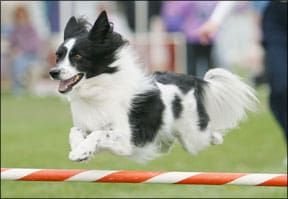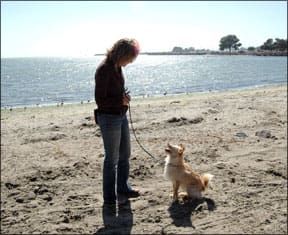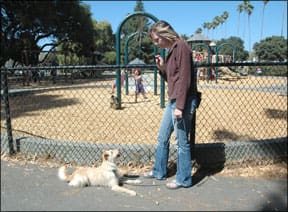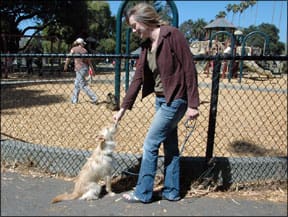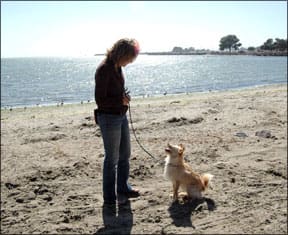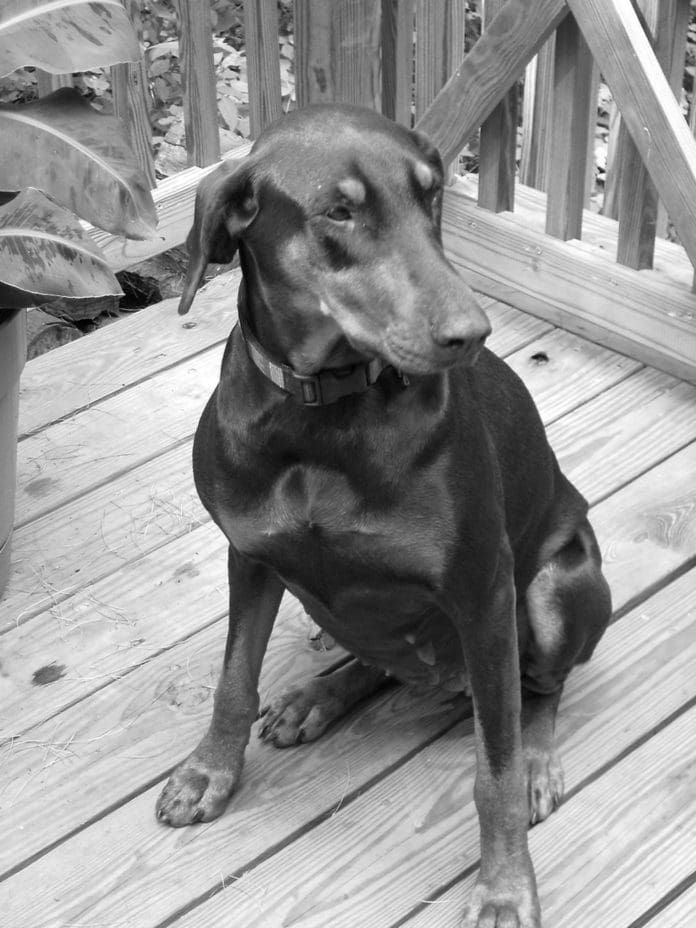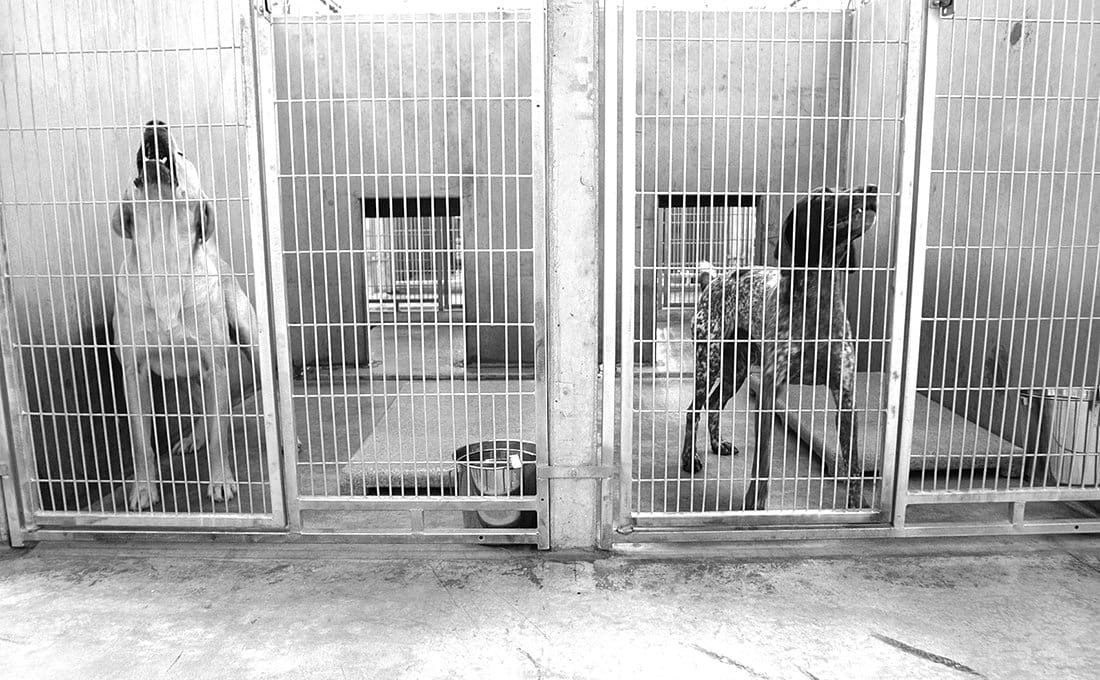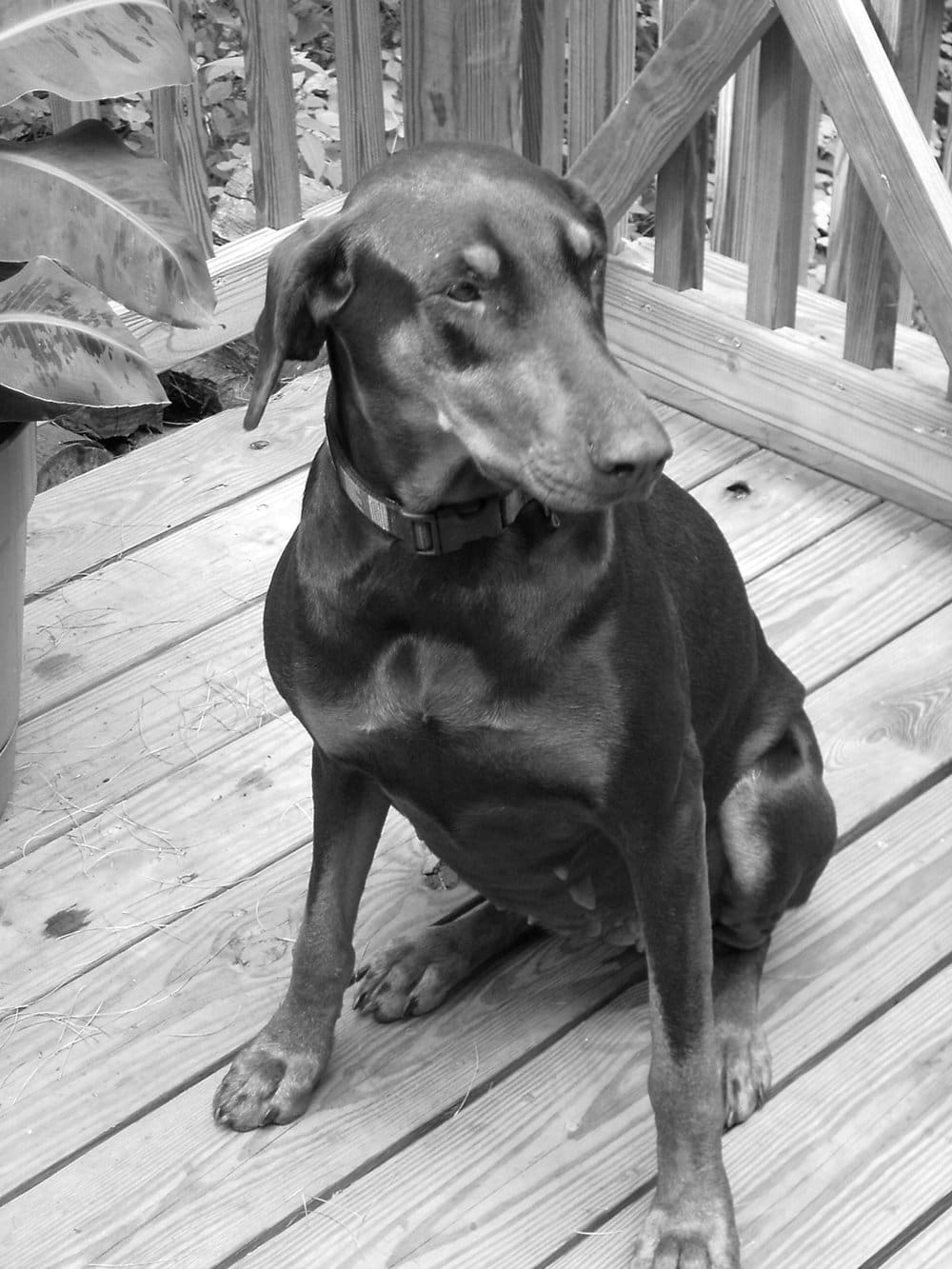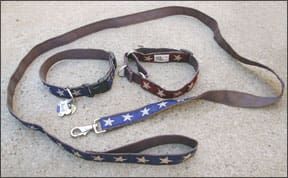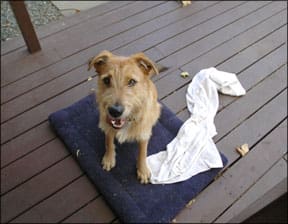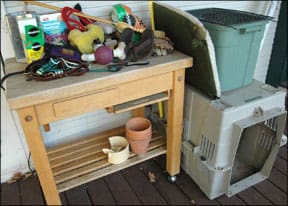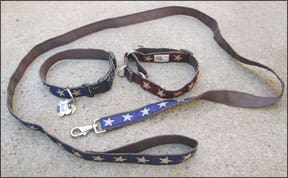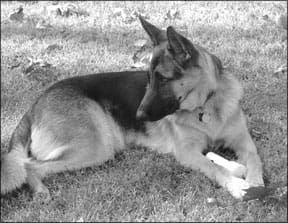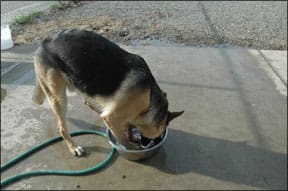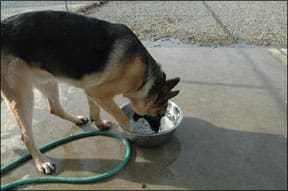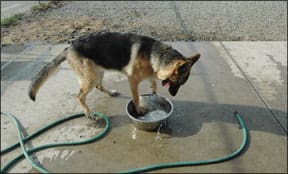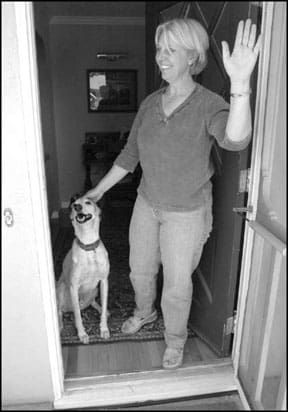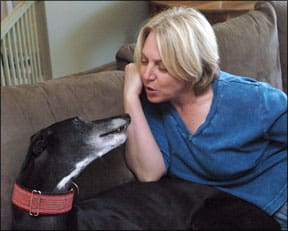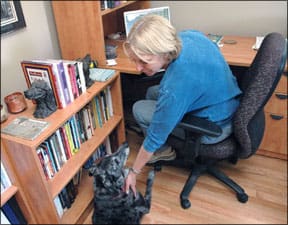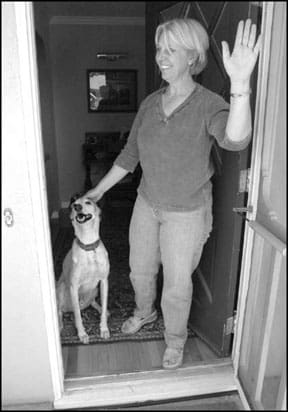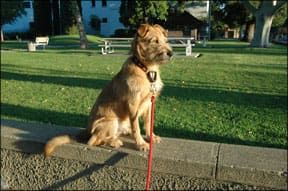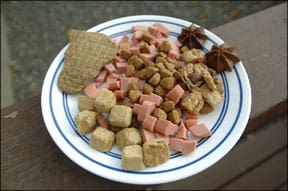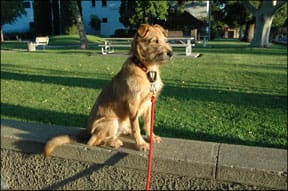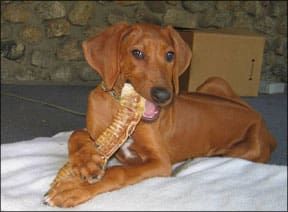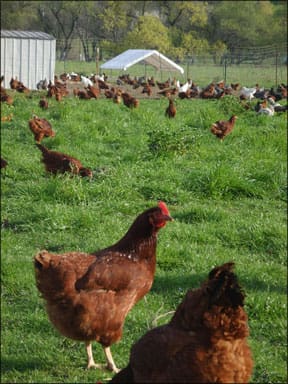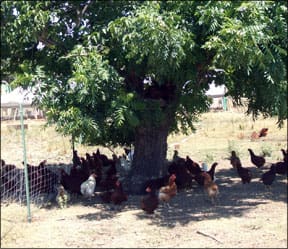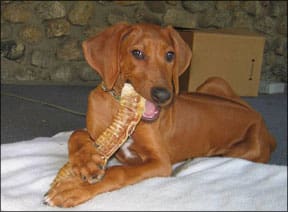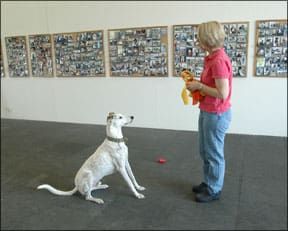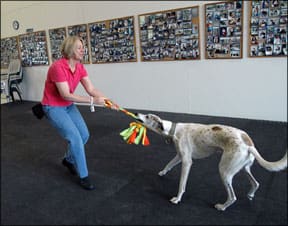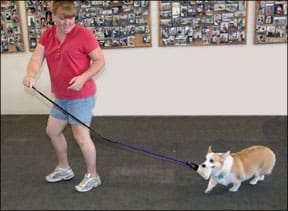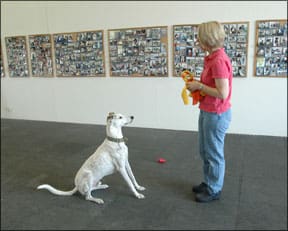At some point in our lives, some of us find ourselves living with a difficult dog, one whose behavior challenges our patience, and exhausts our training knowledge – and opens our hearts and eyes to a new, better way of training. This is the story of one such dog and her very knowledgeable dog owner. Together, they reached an entirely new and higher level of dog training skills, thanks to the owner’s life-altering experiences with a reactive dog who wasn’t fit to compete in the career intended for her: Flyball.
Flyball is not the sport for everyone. It is a relay team event, which means you have to commit to training and competing with your dog and other dogs and dog owners as a team, and you have to have an appreciation for over-the-top dogs and the resulting cacophony of sounds.
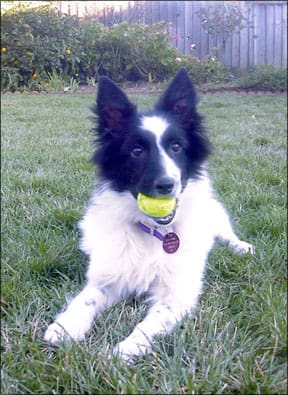
288
In flyball, a team of four dogs race, one after the other, leaping a series of hurdles, throwing their bodies against a spring-loaded box that ejects a tennis ball, snatching the ball, and hurtling their bodies back down the row of jumps to where their next teammates strain to be released for their turns. The fastest team wins.
You hear a typical flyball tournament before you see it. Dogs are barking in excitement and play growling while they play tug between races, and people are screaming encouragement so loudly to their canine teammates that many of them are hoarse the next day. Whistles blast to start races, to alert false starts, and to end races. It can be hard to hear the PA system, which alternately blares announcements and rock and roll music.
Chris Bond loved it all. She and her husband Rich, with three of their Border Collies, were on the Jets, the British flyball team that broke the world record in 1997. They loved it so much that when they moved back to California in 1999, they started their own team, Gold Rush Flyball. They worked with inexperienced pet dogs and owners and trained them to top competition levels. One of their teams achieved a race time of 17.88 seconds – at the time, within one second of the fastest team in their region. What they needed in order to beat the competition was a fast, small dog. Small is important in flyball because the jump height for the team is determined by the shortest dog on the team.
Fate in a small package
In February 2002, Chris was approached by someone from another team who was looking for a home for a small, bright-eyed, five-month-old Border Collie-mix pup that had been found as a stray. That little dog captured Chris and Rich’s hearts and, hoping that she would become the super-fast flyball dog they were looking for, they adopted her on the spot.
Although the little dog showed subtle signs of fearfulness (weight backward on the haunches when she greeted someone, lowered posture, and furtive glances at her surroundings), Chris assumed these were a result of the unfamiliar, noisy environment. They named her “Spryte” because she was as sprightly and cute as a little English pixie.
Other than being a bit nervous and shy, Spryte acted like a “normal” dog for the first two weeks. Then she suddenly began attacking the other household dogs. In one instance, when Misty (a 12-year-old Border Collie) walked by the couch where Spryte and Chris were sitting, Spryte leaped on Misty’s back and began biting her around the neck and shoulders.
Around the same time, Spryte began barking and lunging at unfamiliar dogs and people while out on walks. Her reactivity increased exponentially over the next few weeks. She became reactive to any sudden change in her environment, including loud or unusual noises, and other dogs or people appearing, even at a distance. Often, she would “shut down” for no apparent reason – most likely due to a noise she could hear that her humans could not.
Despite this, Chris’s attachment to Spryte was growing. When Spryte was in what she perceived a “safe” environment, she was very clever, sweet, and personable. Chris had never had a dog like this before. “My husband, Rich, and I were fortunate to have had three beautiful, sociable Border Collies, which we adopted over the years we lived in England. They came to us as puppies from Ghostland Kennels, known for lovely natured dogs. Our dogs were friendly with people, well mannered with other dogs, and full of confidence. They had traveled everywhere with us, and were comfortable in any environment. Nothing fazed them.”
As a result, all of Chris’s experience with training dogs had been with good-natured, resilient dogs; she was now in uncharted territory. She was also coming to the realization that this little dog might not reach the goals Chris longed for. In fact, she might not be a competition dog at all.
By nature, Chris does not give up easily so she decided to start training. But where to start? She had used both lure-and-reward training and traditional, punishment-based methods. Like many people, Chris’s first reaction to any signs of aggression from Spryte was to stop the behavior immediately. When Spryte attacked the other household dogs, Chris would hold her by the scruff and say, “No!” When she lunged and barked at people or dogs while on leash, Chris would jerk the leash and say, “No!” But Spryte’s over-reactivity escalated. When off-leash, she would rush other dogs and people across football-size playing fields. She had to be continuously leashed, and was often left crated in the car to avoid conflicts.
A positive shift
Frustrated and depressed, Chris sought the advice of a friend and professional trainer, Lisa Clifton-Bumpass of Hayward, California. Lisa is a positive trainer and her influence was a turning point in Chris’s relationship with Spryte.
“Lisa changed my understanding of how dogs learn, which probably saved Spryte’s life,” says Chris. “Through Lisa, I learned that fear is an emotion that is highly responsive to classical conditioning. If I punished Spryte in the presence of something she feared, she would begin to fear that thing more. If I rewarded Spryte the in the presence of something she feared before she became reactive, she would begin to associate that thing with good instead of bad, and she would become less fearful. Lisa taught me that punishment was escalating Spryte’s reactivity.”
Lisa recommended Chris avoid all punishment. She gave Chris reading assignments, including Don’t Shoot the Dog by Karen Pryor, and she explained how Spryte’s fears could be reduced through counter-conditioning. She also explained the limits of counter-conditioning, and the amount of time that Chris would need to invest. Months. Years, perhaps. And, although the work would make a profound difference, Spryte would always be what her genetics and prior learning history had made her.
“My heart sank with the realization that I had a true problem dog on my hands, and at the same time rose in the hope that there was something I could do to make things better,” says Chris. “With Lisa’s guidance, I began a positive training regime with Spryte. She earned her meals every day, with food for all her good behaviors.
“For counter-conditioning and desensitization, I took Spryte on leash to a nearby school in the evenings, when only a few children would be playing on the equipment. I stood at the far end of an open field, so far that Spryte was still attentive to me and not paying attention to the children. There, I fed her a continuous stream of food, one morsel at a time. She got all of her favorites: smelly, juicy, cooked steak; cheese; and sausage, chopped into quarter-inch squares. We gradually moved closer to the children, but never so close that she reacted. Before her bag of treats was finished, we would turn and leave. Over time, the distance gradually reduced. Eventually, we were able to play ball at the far end of the field, with her off leash. Things were looking better.”
Clicker training, shaping, and management
Chris also added clicker training to her arsenal of training tools. She played shaping games and practiced behaviors daily. Spryte learned an amazing number of behaviors, including useful skills such as a nose touch and a paw touch to objects. Chris would later use the nose touch to teach her to heel, and the paw touch to teach her agility touch-points.
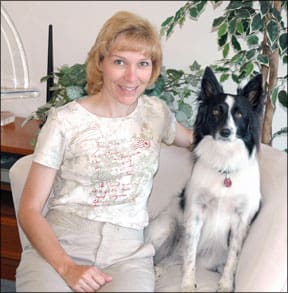
288
Most importantly, Spryte learned that she had control of her environment through behaviors Chris wanted and rewarded, instead of behaviors Chris didn’t want and, therefore, did not allow to be rewarded.
For example, looking calmly at an unfamiliar dog or person was a wanted behavior; lunging at the dog or person was not. So Chris reinforced the wanted behavior by clicking as Spryte first glanced at the dog or person. At the sound of the click, Spryte would instantly turn her head back to Chris for a treat. Spryte soon learned to look at the other dog, then look back. This not only made an enjoyable game out of something that would otherwise be worrying to Spryte, it also taught her a head-turn, which is now one of her signature freestyle (dog dancing) moves.
Because clicker training was fun, it motivated Spryte (and Chris) to learn a variety of exercises. Chris and Spryte trained daily, building foundation skills such as “look at me,” “check the environment, then look back at me,” as well as the basic sit, down, wait, and leave-it behaviors. They participated in several classes, where the training was positive and the environment was calm and spacious. Spryte learned basic obedience, freestyle, tracking, and dock diving.
All the while, Chris worked very hard to manage Spryte’s environment. If they went somewhere, she would check the place before taking Spryte out of the car. If people were there, she would let them know that her dog was reactive, and she was specific about what they should do (avoid eye contact with her, give her space, and not make any sudden movements). Everywhere they went, Spryte was rewarded. And Chris quit activities before her little dog became bored or tired.
It was during this time that Chris accepted that Spryte could not compete in flyball. But she still hoped there was some venue that would allow her to compete with Spryte. She started thinking that perhaps agility would be okay. There, Spryte would have the ring to herself, with just a judge and a few ring stewards. Although there is a lot of activity going on at agility trials, there is only one dog competing at a time, unlike flyball where there can be as many as 16.
Agility class
Chris enrolled in a local class. There were 20 dogs in the class. Fortunately, most were good-natured Shelties. Standing in line with calm dogs her own size, Spryte began to respond positively. Chris asked the people around her to give them space, and she continuously fed Spryte small bits of fresh cooked meat or cheese. She was able to complete the first few training sessions, and things were going well.
Then one evening an Australian Cattle Dog attacked a Border Collie he had been eyeing for several sessions. One of the trainers was badly bitten, and the commotion was too much for Spryte. “Spryte refused food treats and began to bark at the air above her head. She had lost it,” remembered Chris. “The head trainer looked at me and said, ‘Hold her muzzle shut and tell her No!’
“Instead, I knelt down and made eye contact with Spryte. After a moment, her glassy eyes cleared as she recognized me. She came to me quietly and leaned her body into my side. She had learned to trust me. At that moment my heart melted, as a poignant realization hit me to the core: First and foremost, my duty is to protect this little dog. Not just physical protection. Emotional protection as well. I did not return to that training class.”
Some months later, a friend recommended another agility trainer. Kathryn Horn had a long track record in both the sport of agility and positive reinforcement methods. Chris contacted Kathryn and explained her situation. She told her everything she had been working toward over the past nine months and the progress Spryte was making. She asked if she could enroll in her class and use Spryte’s class time to do more counter-conditioning before working on the agility equipment. Chris wanted Spryte to enjoy agility, but knew that years of foundation work lay ahead before they could begin to focus on agility skills.
Kathryn was very understanding, and welcomed Chris into her class. “When I first brought Spryte out of the car, Kathryn automatically knelt down and averted her gaze so she did not make eye contact with Spryte. I was amazed when Spryte trotted up, wiggling with appeasement, and greeted Kathryn without barking. I felt a flood of relief. This was the kind of training instructor Spryte and I needed.”
Kathryn didn’t put any pressure on Chris to teach Spryte agility. Instead, she allowed Chris to teach Spryte that the agility arena was a fun place. The environment Kathryn provided was so supportive, with a small class and plenty of space and one-on-one training, that Spryte’s confidence grew quickly. She was able to practice on agility equipment much earlier than planned.
The agility equipment itself was easy for Spryte. She had some difficulty with the teeter-totter because of the noise; otherwise, she had no fear of the equipment. For touch-points (teaching a dog to stop at the bottom of the dogwalk, A-frame, and teeter), Kathryn taught bow-on-a-mat using clicker training. Spryte loved touch-points so much that she began seeking out the A-frame and dogwalk.
“Because my goal was to build confidence, I rewarded everything Spryte offered, as long as it was not fearful behavior. It worked. Spryte began to show excitement in the car when we neared the agility-training site, and confidence when she was in the training arena. As the months passed, she began to look like a true agility dog.”
Dealing with setbacks
Spryte’s progress was not always unremitting. One night as they were training, a ranch hand started the diesel engine of a Mac truck. The noise was sudden, loud, and startling. Spryte shut down. She became frenetic, looking for a place to hide, body tucked low in an attempt to become invisible. After the truck left, Chris tried to bring her out of it, but Spryte was unable to cope, so Chris took her home.
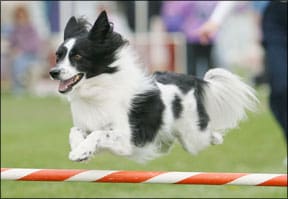
Photo copyright Dave Mills.
288
The following week when they neared the agility site, Spryte curled herself up in her crate. Fearful, she refused to come out of her crate, so they sat together in the car, watching the other dogs run, and Chris focused once again on counter-conditioning, feeding her bits of meat and cheese just for being there. Spryte took the food timidly at first, and then began to relax a little. But she still would not leave her crate.
“It was very depressing; I was starting all over again,” describes Chris. “My goals of a competition dog were, once again, slipping away. I thought about quitting. I had put so much work in building her confidence, and here we were back to square one. I decided to continue agility for a couple of months and, if she didn’t bounce back, we would leave the sport. After all, we were doing this for fun, and right then, it wasn’t fun for either one of us.”
Over the next few weeks, Spryte gradually became less fearful. Kathryn avoided using the teeter during that time so Spryte wouldn’t have a setback. Once her fears had subsided, her confidence bounced right back to where it had been before the event. Because Chris had worked through the problem, the bond between them seemed to grow. Lisa had given sound training advice that paid off over the months and years: Set short, attainable goals, and look at the behavior modification program from a long-term perspective.
After four years of agility training with Kathryn, Spryte was doing beautifully in practice and Chris was learning how to give verbal and physical cues smoothly to keep her confidence high. But she was so worried that Spryte would rush and bark at the agility judge that she avoided entering a competition. Finally, Kathryn convinced her to enter Spryte in a small competition where Kathryn would be judging some of the classes.
The payoff
On the day of the competition, Kathryn made sure all the judges, ring stewards, and helpers knew that Spryte was fearful and not to approach her. Kathyrn even saved Chris a parking spot in a quiet, shady spot, away from everyone else.
Kathryn was judging the first round. The plan was to walk Spryte into the ring, do a couple of obstacles, then mark (i.e., “Yes!”), and leave the ring to give her loads of treats. Chris’s goal was for both of them to completely forget about the dogs and people around them and play together, just for a moment. Chris describes their breakthrough:
“I walked Spryte in and out of the barn to introduce her to the area before our round, working some freestyle moves and giving her treats. She was tense. Then, when our turn came, we went straight into the ring, treat-less and leash-free. I said, ‘Ready, go over!’ Spryte flew forward, sailed over the jump, right past a helper – without even a glance – and up the dogwalk. We connected at the base of the dogwalk, and then she was off over the next jump, tunnel, and so on. Before I knew it, she’d done the entire course, about 15 obstacles – fast, happy, and absolutely connected with me the whole way. I threw my arms up with a big “Yes!” as she sailed over the last jump. She responded by bouncing on her hind legs. She was still playing. I was absolutely amazed.”
Chris and Spryte had done far more than achieve their goal. They not only made it through the entire course, but won first place in her height group. Spryte was also the third fastest out of 17 dogs in the Novice class. And she achieved a qualifying round toward her first agility title.
Chris and Spryte ran two more perfect courses, winning yet another first place and qualifying for points toward two titles. Most importantly, she was able to play agility happily among unfamiliar people and dogs, in an unfamiliar place. The classical conditioning of the agility obstacles was so strong that it transferred to a new location better than Chris expected.
“Throughout the day, several people commented how well we were doing for our first time. That was pretty cool. Especially given the true ‘obstacles’ we had tackled together. Of course, even if she hadn’t done all that, Spryte is still very special to me. She taught me how to be a better trainer and a better partner in our agility team.”
As Spryte’s confidence in the world has grown, Chris has focused more on agility. Since that inaugural competition, Spryte and Chris have entered five more agility competitions, qualified in 11 runs across four different classes, and earned two titles: Novice Regular and Novice Touch-n-Go. To a spectator, Spryte looks like a “normal” agility dog. She barked at the judge once, and at a cameraman once. But she recovered quickly on both occasions, and finished the course.
Spryte is a work in progress. She has provided Chris with many challenges, setbacks, and disappointments, but also a lot of joy and achievement. “The road to success with Spryte has been long and winding, with lots of dips and rises, but we’re enjoying the journey together,” says Chris.
Because she is so aware of every little thing around her, Spryte has taught Chris to be aware of her, to observe her, and respond to her needs each moment.
“The lessons Spryte has taught me have made me a better trainer,” says Chris. “She has taught me that trust, even in the human-dog relationship, requires patience, consistency, and clear communication beyond verbal language. She has also taught me that communication is two-way: To succeed as a team, I must listen to my dog and understand her emotional needs. In this way, Spryte has provided a service not only for herself, but for all the competition dogs that share my life in future.”
Terry Long, CPDT, is a writer, agility instructor, and behavior counselor in Long Beach, CA. Terry lives with four dogs and a cat and is addicted to agility and animal behavior.
Chris Bond lives with her husband and three Border Collies in Dublin, CA. Since her introduction to clicker training, Chris earned a diploma in Advanced Canine Behavioral Sciences with Companion Animal Sciences Institute, and has become a CAP assessor.


